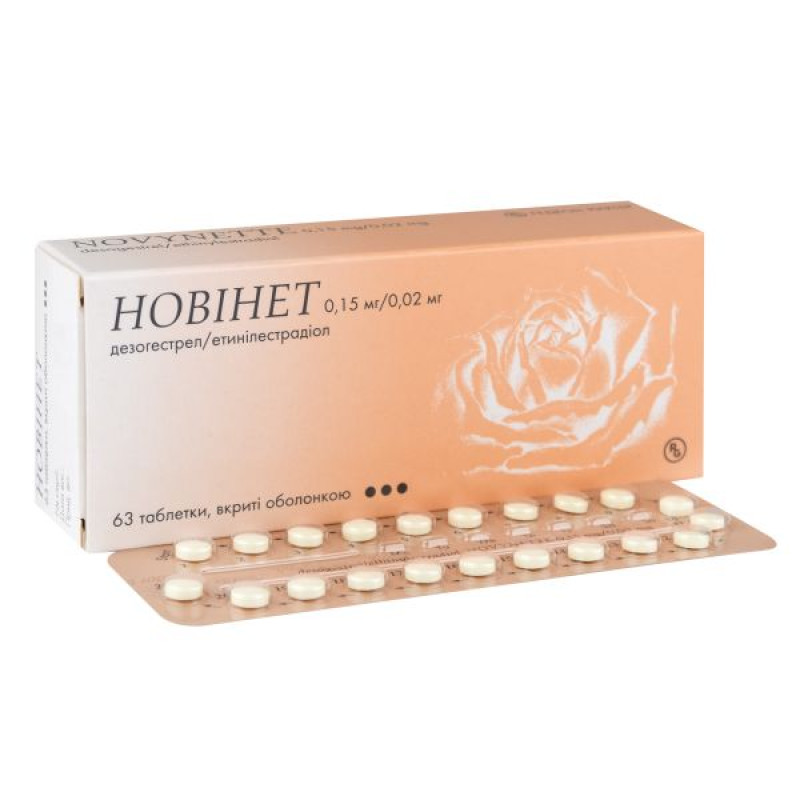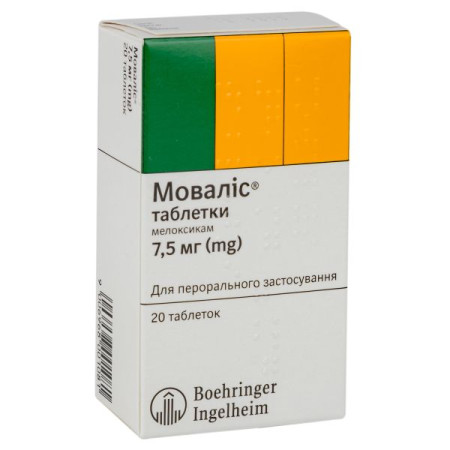Novinet film-coated tablets blister No. 63

Instructions for Novinet film-coated tablets blister pack No. 63
Composition
active ingredients: desogestrel, ethinylestradiol;
1 film-coated tablet contains desogestrel 0.15 mg and ethinylestradiol 0.02 mg;
excipients: quinoline yellow (E 104), alpha-tocopherol (all-rac-α-tocopherol), magnesium stearate, colloidal anhydrous silicon dioxide, stearic acid, povidone, potato starch, lactose monohydrate;
Shell composition: propylene glycol, macrogol 6000, hypromellose.
Dosage form
Film-coated tablets.
Main physicochemical properties: pale yellow, round, biconvex, film-coated tablets, approximately 6 mm in diameter, marked “P9” on one side of the tablet and “RG” on the other.
Pharmacotherapeutic group
Hormonal contraceptives for systemic use, progestogens and estrogens.
ATX code G03A A09.
Pharmacological properties
Pharmacodynamics
The contraceptive effect of combined oral contraceptives (COCs) is based on the interaction of various factors, the most important of which are the suppression of ovulation and changes in cervical secretion. In addition to preventing pregnancy, COCs have certain positive properties, which, like the negative effects (see the sections "Features of use" and "Adverse reactions") can be useful when choosing a method of birth control. They contribute to the establishment of a regular menstrual cycle, menstruation is less painful, with less intense bleeding. The latter circumstance may reduce the incidence of iron deficiency.
In addition, there is evidence that high-dose COCs (0.05 mg ethinylestradiol) reduce the incidence of benign breast tumors, ovarian cysts, pelvic inflammatory disease, ectopic pregnancy, endometrial cancer, and ovarian cancer. However, it is not yet confirmed whether this also applies to low-dose COCs.
Pharmacokinetics
Desogestrel
Absorption: Orally administered desogestrel is rapidly and completely absorbed and converted to etonogestrel. Peak serum concentrations are reached within approximately 1.5 hours. Bioavailability is 62–81%.
Distribution. Etonogestrel binds to serum albumin and sex hormone binding globulin (SHBG). Only 2–4% of the total amount of the drug in serum is present as free steroid, and 40–70% is specifically bound to SHBG. The increase in SHBG caused by ethinylestradiol affects the distribution between serum proteins, increasing the fraction bound to SHBG and decreasing the fraction bound to albumin. The volume of distribution of desogestrel is 5 l/kg.
Biotransformation. Etonogestrel is completely metabolized by known steroid metabolism pathways. The rate of elimination of metabolites from serum is approximately 2 ml/min/kg. No interaction of etonogestrel with concomitantly administered ethinylestradiol has been identified.
Elimination: Serum levels of etonogestrel decline in two phases. The terminal elimination phase is characterized by a half-life of approximately 30 hours. Desogestrel and its metabolites are excreted in the urine and bile in a ratio of 6:4.
Steady state. The pharmacokinetics of etonogestrel are influenced by serum GH levels, which increase threefold when ethinylestradiol is administered. With daily administration, steady state is reached in the second half of the cycle, when serum etonogestrel concentrations increase 2-3-fold.
Ethinylestradiol
Absorption. After oral administration, ethinylestradiol is rapidly and almost completely absorbed. The maximum concentration in the blood plasma is reached after approximately 1-2 hours. The absolute bioavailability of the drug due to presystemic conjugation and the first-pass effect is about 60%.
Distribution: Ethinylestradiol is highly but non-specifically bound to serum albumin (approximately 98.5%) and causes an increase in serum concentrations of GH. The expected volume of distribution is 5 l/kg.
Biotransformation. Ethinylestradiol undergoes presystemic conjugation in the small intestinal mucosa and liver. Ethinylestradiol is mainly metabolized by aromatic hydroxylation, but many other hydroxylated and methylated metabolites are also formed, which are found as free metabolites, as well as in the form of conjugated sulfates and glucuronides. The metabolic clearance rate is approximately 5 ml/min/kg.
In vitro, ethinylestradiol is a reversible inhibitor of CYP2C19, CYP1A1 and CYP1A2, and an irreversible inhibitor of CYP3A4/5, CYP2C8 and CYP2J2.
Elimination. The serum level of ethinylestradiol decreases in a biphasic manner, the final elimination phase is characterized by a half-life of approximately 24 hours. Ethinylestradiol is not excreted unchanged, its metabolites are excreted in the urine and bile in a ratio of 4:6. The half-life of metabolites is approximately one day.
Steady state. Steady state is reached after 3-4 days, when the concentration of the drug in the blood serum is approximately 30-40% higher compared to a single dose.
Indication
Before prescribing Novinet, the woman's individual risk factors should be assessed, especially those related to the risk of venous thromboembolism (VTE), and the risk of venous thromboembolic complications when taking Novinet should be compared with the risk when taking other combined hormonal contraceptives (CHCs) (see sections "Contraindications" and "Special Instructions for Use").
Contraindication
Combined hormonal contraceptives (CHCs) should not be used in the following conditions. If such a condition occurs for the first time while taking CHCs, they should be stopped immediately.
Known or suspected pregnancy; Presence or risk of venous thromboembolism (VTE). Current or past history of venous thromboembolism, particularly as a result of anticoagulant therapy (e.g. deep vein thrombosis (DVT) or pulmonary embolism (PE). Known hereditary or acquired predisposition to venous thromboembolism, such as resistance to activated protein C (including factor V Leiden mutation), antithrombin III deficiency, protein C deficiency, protein S deficiency.
Major surgery with prolonged immobilization (see section "Special instructions").
High risk of venous thromboembolism due to the presence of multiple risk factors (see section "Special warnings and precautions for use").
Presence or risk of arterial thromboembolism (ATE). Current or history of arterial thromboembolism (e.g. myocardial infarction) or prodromal state (e.g. angina). Cerebrovascular disease – current or history of stroke or prodromal state (e.g. transient ischemic attack (TIA)). Known hereditary or acquired predisposition to arterial thromboembolism, such as hyperhomocysteinemia and presence of antiphospholipid antibodies (anticardiolipin antibodies, lupus anticoagulant). History of migraine with focal neurological symptoms.
High risk of developing ATE due to the presence of multiple risk factors (see section "Special warnings and precautions for use") or the presence of one of the following serious risk factors: diabetes mellitus with vascular complications; severe arterial hypertension; severe dyslipoproteinemia.
Current or history of pancreatitis associated with severe hypertriglyceridemia. Current or history of severe liver disease until liver function tests return to normal. Current or history of liver tumors (benign or malignant). Known or suspected malignant tumors (e.g., genital or breast) that are sex hormone dependent. Endometrial hyperplasia. Vaginal bleeding of unknown etiology. Hypersensitivity to the active substances or to any of the excipients of the drug.
Novinet is contraindicated for concomitant use with medicinal products containing ombitasvir/paritaprevir/ritonavir and dasabuvir (see sections “Special warnings and precautions for use” and “Interaction with other medicinal products and other types of interactions”).
Interaction with other medicinal products and other types of interactions
Caution: To identify possible drug interactions, the information contained in the instructions for medical use of other drugs used simultaneously should be considered.
Pharmacodynamic interactions
Concomitant use with medicinal products containing ombitasvir/paritaprevir/ritonavir and dasabuvir, with or without ribavirin, may increase the risk of ALT elevations (see sections 4.3 and 4.4). Patients taking Novinet should switch to an alternative method of contraception (e.g. progestogen-only contraceptives or non-hormonal methods) before starting combination therapy. Novinet can be restarted 2 weeks after completing combination therapy.
Pharmacokinetic interactions
Effect of other medicines on Novinet
Interaction with drugs that induce microsomal enzymes is possible, as a result of which the clearance of sex hormones may increase, which may lead primarily to breakthrough bleeding and/or contraceptive failure.
Tactics
Enzyme induction can be observed within a few days of administration. Maximum enzyme induction is usually observed within a few weeks. After drug withdrawal, enzyme induction may persist for up to 4 weeks.
Short-term treatment
Women taking enzyme-inducing drugs are advised to temporarily use a barrier method of contraception or another method of contraception in addition to the COC. The barrier method of contraception should be used throughout the entire period of concomitant therapy and for 28 days after its discontinuation. If the use of the inducer drug continues after taking the last tablet of the COC from the current package, the new package should be started without the usual tablet-free interval.
Long-term treatment
The following interactions have been described in the literature:
Substances that increase the clearance of PDA (reduced PDA efficacy due to enzyme induction), for example: barbiturates, bosentan, carbamazepine, phenytoin, primidone, rifampicin and the human immunodeficiency virus (HIV) treatment ritonavir, nevirapine and efavirenz, possibly also felbamate, griseofulvin, oxcarbazepine, topiramate and preparations containing St. John's wort (Hypericum perforatum).
Substances that have a variable effect on COC clearance: When used concomitantly with COCs, many combinations of HIV protease inhibitors and non-nucleoside reverse transcriptase inhibitors, including combinations with hepatitis C virus protease inhibitors, may increase or decrease plasma concentrations of estrogens or progestins. The effect of these changes may be clinically significant in some cases.
Therefore, the information contained in the Summary of Product Characteristics of concomitant medications used for the treatment of HIV/hepatitis C should be considered for possible drug interactions and related recommendations. In case of any doubt, women receiving protease inhibitors or non-nucleoside reverse transcriptase inhibitors should use an additional barrier method of contraception.
Active substances that reduce the clearance of Novinet (enzyme inhibitors)
The clinical significance of the potential interaction with enzyme inhibitors remains unclear.
Concomitant use with potent (e.g. ketoconazole, itraconazole, clarithromycin) or moderate (e.g. fluconazole, diltiazem, erythromycin) CYP3A4 inhibitors may lead to increased serum concentrations of estrogens or progestogens, including etonogestrel.
Etoricoxib at doses of 60 to 120 mg/day has been shown to increase plasma concentrations of ethinyl estradiol by 1.4- to 1.6-fold, respectively, when co-administered with a combined hormonal contraceptive containing 0.035 mg ethinyl estradiol.
The effect of Novinet on other medicines
Oral contraceptives may affect the metabolism of other drugs. Accordingly, their plasma and tissue concentrations may either increase (e.g., cyclosporine) or decrease (e.g., lamotrigine).
Clinical data suggest that ethinylestradiol inhibits the clearance of CYP1A2 substrates, which in turn causes a slight (e.g., when using theophylline) or moderate (e.g., when using tizanidine) increase in their plasma concentrations.
Other interactions
Laboratory tests
The use of steroid contraceptives may affect the results of certain laboratory tests, such as biochemical parameters of liver, thyroid, adrenal and renal function, as well as levels of plasma transport proteins such as corticosteroid-binding globulin and lipid/lipoprotein fractions, indicators of carbohydrate metabolism, coagulation and fibrinolysis. Usually, changes are within the normal range of laboratory values.
Application features
Warning
If any of the following conditions or risk factors are present, the need for Novinet should be discussed with the woman.
In case of exacerbation of the course or manifestations of any conditions or risk factors, women are advised to contact their doctor and discuss with him the possibility of discontinuing the use of the drug Novinet.
1. Circulatory system disorders
Risk of venous thromboembolism (VTE)
The use of combined hormonal contraceptives (CHCs) increases the risk of venous thromboembolism (VTE) in patients who take them compared with those who do not take these drugs.
Use of products containing levonorgestrel, norgestimate or norethisterone is associated with a lower risk of VTE. Other products such as Novinet may double the risk of VTE. The decision to use a product that is not among those with the lowest risk of VTE should only be made after discussion with the woman. It is necessary to ensure that she is aware of the risk of VTE associated with the use of Novinet, the extent to which her existing risk factors affect the level of this risk and the fact that the risk of VTE is highest during the first year of use. In addition, there is evidence that the risk is increased when resuming the use of combined hormonal contraceptives after a break of 4 weeks or more.
About 2 in 10,000 non-pregnant women and women not using CHCs will develop VTE in a year. However, a woman's individual risk may be much higher, depending on her risk factors (see below).
It is estimated1 that out of 10,000 women who use desogestrel-containing CHCs, 9–12 will develop a VTE in a year (compared with around 62 cases among women who use levonorgestrel-containing CHCs).
In both cases, the number of VTEs per year is lower than that expected during pregnancy or the postpartum period. VTE can be fatal in 1–2% of cases.
2 - The median range of 5–7 per 10,000 women-years is based on the relative risk for CHCs containing levonorgestrel compared to those not using them, and is approximately 2.3–3.6.
In isolated cases, thrombosis of other vessels (e.g. hepatic, mesenteric, renal or retinal veins and arteries) has been reported in women taking CHCs.
Risk factors for developing venous thromboembolism (VTE)
The risk of venous thromboembolic complications may be significantly increased in women with additional risk factors when using CHCs, especially in the presence of multiple risk factors (see Table 1).
Novinet is contraindicated in women with multiple risk factors that place them at high risk of developing venous thrombosis (see section 4.3). If a woman has more than one risk factor, the increased risk may be greater than the sum of the risks associated with each individual factor, in which case the overall risk of VTE should be considered. CHCs should not be used if the benefit/risk ratio is considered to be negative (see section 4.3).
Table 1
Risk factors for developing venous thromboembolism (VTE)
| Risk factor | Note |
| Obesity (body mass index more than 30 kg/m2) | The risk increases significantly with increasing body mass index. It especially requires attention if women have other risk factors. |
Prolonged immobilization, major surgery, any surgery on the lower extremities or pelvic organs, neurosurgery, or major trauma. Note: Temporary mobilization, including air travel of more than 4 hours, may also be a risk factor for VTE, especially for women with other risk factors. | In such cases, it is recommended to stop using the patch/pill/vaginal ring (in the case of elective surgery - at least 4 weeks in advance) and not resume use earlier than 2 weeks after full recovery of motor activity. To avoid unwanted pregnancy, other methods of contraception should be used. If Novinet has not been discontinued in advance, the possibility of antithrombotic therapy is considered. |
| Family history (cases of venous thromboembolism in close relatives – brothers, sisters or parents, especially at a relatively young age, i.e. under the age of 50). | If a hereditary predisposition is suspected, the woman should be referred for specialist advice before deciding to use any CHC. |
| Other conditions associated with VTE | Cancer, systemic lupus erythematosus, hemolytic uremic syndrome, chronic inflammatory bowel disease (Crohn's disease or ulcerative colitis), and sickle cell anemia. |
| Increasing age | Especially over 35 years old. |
There is no consensus on the possible impact of varicose veins and superficial thrombophlebitis on the development or progression of venous thrombosis.
It should also be taken into account that the risk of thromboembolic complications increases during pregnancy and in the first 6 weeks after delivery (see section "Use during pregnancy or breastfeeding").
Symptoms of venous thromboembolism (VTE)
Women should be advised that if they experience symptoms of VTE, they should seek emergency medical attention and inform their healthcare professional about their CHC use.
Symptoms of deep vein thrombosis (DVT) may include:
unilateral swelling of the leg and/or foot or an area along a vein in the leg; pain or increased sensitivity in the leg that may only be felt when standing or walking;
a feeling of heat in the affected leg; redness or discoloration of the skin on the leg.
Symptoms of pulmonary embolism (PE) may include:
sudden shortness of breath for no apparent reason or rapid breathing; sudden cough for no apparent reason, possibly with blood; sharp chest pain; fainting or dizziness; rapid or irregular heartbeat.
Some of these symptoms (e.g., shortness of breath, cough) are nonspecific and may be mistaken for more common or less severe illnesses (e.g., respiratory tract infections).
Other signs of a vascular embolism may include: sudden pain, swelling, and slight blueness of the limb.
In the case of an ocular embolism, symptoms can range from blurred vision (without pain) that can progress to vision loss. Sometimes, complete vision loss develops almost instantly.
Risk of developing arterial thromboembolism (ATE)
Epidemiological studies have linked the use of CHCs to an increased risk of arterial thromboembolic events (myocardial infarction) or cerebrovascular accidents (e.g. transient ischemic attack, stroke). Cases of arterial thromboembolism can be fatal.
The risk of developing ATE or cerebrovascular accidents with CHC use is increased in women with risk factors (see Table 2). Novinet is contraindicated in women with one serious risk factor or multiple risk factors for ATE, on the basis of which she can be attributed to a group of high risk of arterial thromboembolism (see section "Contraindications"). If a woman has more than one risk factor, the increased risk may be greater than the sum of the risks associated with each individual factor, so the overall risk of ATE should be taken into account. CHCs should not be prescribed if the benefit/risk ratio is assessed as negative (see section "Contraindications").
Table 2
Risk factors for arterial thromboembolism (ATE)
| Risk factor | Note |
| Increasing age | Especially over 35 years old |
| Smoking | Women should be advised to quit smoking if they wish to use CHCs. Women aged 35 years and over who have not quit smoking should be strongly advised to use another method of contraception. |
| Arterial hypertension | |
| Obesity (body mass index more than 30 kg/m2) | The risk increases significantly with increasing body mass index. This is especially important if women have additional risk factors. |
| Family history (cases of arterial thromboembolism in close relatives – brothers, sisters or parents, especially at a relatively early age, i.e. under the age of 50) | If a hereditary predisposition is suspected, a woman should be referred for consultation with a specialist before deciding to use any CHC. |
| Migraine | An increase in the frequency or severity of migraine during CHC use (which may be a precursor to cerebrovascular accident) may be a reason for immediate discontinuation of the drug. |
| Other conditions associated with adverse vascular reactions | Diabetes mellitus, hyperhomocysteinemia, heart valve defects and atrial fibrillation, dyslipoproteinemia, and systemic lupus erythematosus. |
Symptoms of arterial thromboembolism (ATE)
Women should be advised that if the following symptoms occur, they should seek immediate medical attention and inform the healthcare professional about their CHC use.
Symptoms of cerebral circulation disorders may include:
sudden numbness of the face, weakness or numbness of the limbs, especially on one side; sudden trouble walking, dizziness, loss of balance or coordination; sudden confusion, trouble speaking or understanding; sudden loss of vision in one or both eyes; sudden severe or prolonged headache with no known cause; loss of consciousness or fainting with or without seizures.
The temporary nature of the symptoms may indicate a transient ischemic attack (TIA).
Symptoms of myocardial infarction may include:
pain, discomfort, pressure, heaviness, a feeling of squeezing or bursting in the chest, arm or behind the breastbone; discomfort radiating to the back, lower jaw, throat, arm, stomach; a feeling of fullness in the stomach, indigestion or heartburn; increased sweating, nausea, vomiting or dizziness; severe weakness, restlessness or shortness of breath; fast or irregular heartbeat.
2. Tumors
Long-term use of oral contraceptives is known to be a risk factor for cervical cancer in women infected with human papillomavirus (HPV). However, this statement remains controversial, as it is not yet clear to what extent the results of studies account for the influence of concomitant risk factors (for example, differences in the number of sexual partners or the use of barrier contraceptive methods).
A meta-analysis of 54 international studies suggests a small increased relative risk (RR = 1.24) of breast cancer in women who use COCs. This increased risk gradually disappears within 10 years after stopping COC use. Since breast cancer is rare in women under 40 years of age, the increase in the number of breast cancer diagnoses in women who are current or recent users of COCs is insignificant in relation to the overall risk of breast cancer. The results of these studies do not provide evidence of a causal relationship. The increased risk may be due to earlier diagnosis of breast cancer in women who use COCs, the biological action of COCs, or a combination of both. There is a trend that breast cancers found in women who have ever used COCs are usually clinically less severe than in women who have never used COCs.
In isolated cases, benign and even more rarely malignant liver tumors have been observed in women using COCs. In some cases, these tumors have caused life-threatening intra-abdominal bleeding. In the event of complaints of severe epigastric pain, liver enlargement or signs of intra-abdominal bleeding, the possibility of a liver tumor in women using COCs should be considered in the differential diagnosis.
Depressed mood and depression are common adverse reactions with hormonal contraceptives (see section 4.8). Depression can be severe and is a known risk factor for suicidal behaviour and suicide. Women should be advised to seek medical advice if they experience mood swings and symptoms of depression, even if they occur soon after starting treatment.
In women with hypertriglyceridemia or a family history of hypertriglyceridemia, a possible increased risk of pancreatitis should be considered when using CHCs.
Although many women using COCs have experienced a slight increase in blood pressure, clinically significant increases are rare. No association has been found between COC use and clinically significant hypertension. However, in the event of clinically significant hypertension that persists during COC use, it is advisable to discontinue COC use and initiate treatment for hypertension. If necessary, COC use may be resumed if normal blood pressure values have been achieved with antihypertensive therapy.
The following conditions have been reported to occur or worsen during pregnancy and COC use, but the relationship between the two conditions and COC use is not conclusive: jaundice and/or pruritus associated with cholestasis; gallstones; porphyria; systemic lupus erythematosus; haemolytic uraemic syndrome; Sydenham's chorea; herpes gestationis; hearing loss associated with otosclerosis; (hereditary) angioedema.
Acute or chronic liver dysfunction may require discontinuation of COCs until liver function tests return to normal. Recurrence of cholestatic jaundice, which first occurred during pregnancy or with previous use of sex steroids, requires discontinuation of COCs.
Although CHCs may affect peripheral insulin resistance and glucose tolerance, there is no evidence that a change in the therapeutic regimen is necessary in diabetic women taking COCs. However, diabetic women taking COCs should be under close medical supervision.
The use of COCs has been associated with an increased risk of developing ulcerative colitis and Crohn's disease.
Chloasma may occasionally develop (especially in women with a history of chloasma during pregnancy). Women with a tendency to chloasma should avoid exposure to sunlight or ultraviolet radiation while using CHCs.
All of the above information should be considered when choosing a contraceptive method(s).
Medical examination/consultation
Before initiating or reinstituting Novinet, a careful medical history (including family history) should be taken and pregnancy should be ruled out. Blood pressure should be measured and a physical examination should be performed, guided by the information on contraindications (see section "Contraindications") and special instructions and precautions (see section "Special instructions").
It is important to draw women's attention to the risk of venous and arterial thrombosis, including the risk of Novinet compared with other CHCs, the symptoms of VTE and ATE, as well as the established risk factors and the necessary actions in case of suspicion of thrombosis. It is necessary for the woman to carefully read the instructions for medical use and follow the recommendations specified in it. The frequency and nature of the examinations should be based on existing standards of medical practice, taking into account the individual characteristics of each woman.
A woman should be warned that hormonal contraceptives do not protect against HIV infection (AIDS) and other sexually transmitted diseases.
Reduced contraceptive effectiveness
The effectiveness of CHCs may be reduced in the event of missed tablets, gastrointestinal disorders (see section “Method of administration and dosage”) or when other medicines are used simultaneously (see section “Interaction with other medicines and other types of interactions”).
Due to the risk of reducing the concentration of Novinet in the blood plasma, as well as reducing clinical effects, its simultaneous use with herbal preparations containing St. John's wort (Hypericum perforatum) should be avoided (see section "Interaction with other medicinal products and other types of interactions").
Menstrual cycle control
Irregular bleeding (spotting or breakthrough bleeding) may occur with any CHC, especially during the first months of use. Therefore, any irregular bleeding is only meaningful after an adaptation period of approximately 3 cycles.
Some women may not have a menstrual period during the break in taking oral contraceptives. If a woman has used CHCs according to the instructions described in the section "Method of administration and dosage", it is unlikely that she will become pregnant. However, if CHC use was irregular until the first withdrawal bleed was missed or if menstrual bleeding is absent for two cycles, pregnancy should be ruled out before continuing CHC use.
Elevated ALT (alanine aminotransferase)
It is known that in clinical trials in patients treated with medicinal products containing ombitasvir/paritaprevir/ritonavir and dasabuvir with or without ribavirin for the treatment of hepatitis C virus infections, ALT elevations greater than 5 times the upper limit of normal have been observed, occurring more frequently in women using medicinal products containing ethinylestradiol, such as CHCs (see sections 4.3 and 4.5). Novinet should be discontinued prior to initiating combination therapy for hepatitis C virus infection that includes ombitasvir/paritaprevir/ritonavir with or without dasabuvir (see sections 4.3 and 4.5). Novinet should be restarted approximately 2 weeks after completion of combination therapy.
Novinet contains lactose. Women with rare hereditary problems of galactose intolerance, the Lapp lactase deficiency or glucose-galactose malabsorption should not take this medicine.
Ability to influence reaction speed when driving vehicles or other mechanisms
The effect of PDA on the ability to drive vehicles or other mechanisms has not been identified.
Use during pregnancy or breastfeeding
Pregnancy
Novinet is not used during pregnancy. Pregnancy should be ruled out before starting Novinet. If pregnancy occurs while taking Novinet, its use should be discontinued immediately.
According to the results of epidemiological studies, the frequency of congenital anomalies in newborns whose mothers took oral contraceptives before pregnancy does not exceed the normal level, in addition, in the case of the use of oral contraceptives in the early stages of pregnancy, no teratogenic effect from their use was observed.
When re-prescribing Novinet, the increased risk of VTE in the postpartum period should be taken into account (see sections “Method of administration and dosage” and “Special precautions for use”).
Breastfeeding period
Taking oral contraceptives may reduce the amount of breast milk and change its composition; moreover, this group of drugs penetrates into breast milk (however, there is no evidence of an undesirable effect on the health of the child); therefore, the use of Novinet is not recommended for women who are breastfeeding.
Small amounts of steroid hormones and/or their metabolites may pass into breast milk, but there is no evidence of adverse effects on the health of the child.
Method of administration and doses
Doses
Start taking the tablets on the first day of your period and take 1 tablet per day for 21 days without a break, if possible at the same time of day. Then take a 7-day break, during which you will have a withdrawal bleed. The day after the 7-day break (4 weeks after taking the first tablet, on the same day of the week), start taking the drug from the next blister pack, which also contains 21 tablets, even if bleeding has not stopped. This regimen should be followed as long as contraception is needed. If you follow your doctor's instructions, the contraceptive effect will be maintained during the 7-day break in taking the tablets.
The tablets must be taken orally, in order,
There are no reviews for this product.
There are no reviews for this product, be the first to leave your review.
No questions about this product, be the first and ask your question.










